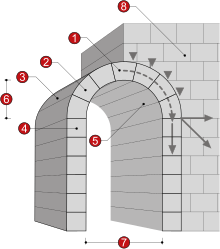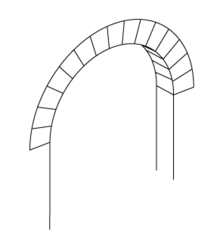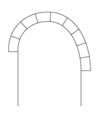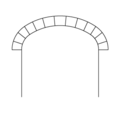Arch
This article needs additional citations for verification. (December 2007) |

1. Keystone 2. Voussoir 3. Extrados 4. Impost 5. Intrados 6. Rise 7. Clear span 8. Abutment
An arch is a structure capable of spanning a space while supporting significant weight (e.g. a doorway in a stone wall). True arches appeared as early as the 2nd millennium BC in Mesopotamian brick architecture and in Persian ziggurats (see Chogha Zanbil). True arches were also built by the Babylonians in the 6th century BC (see Ishtar Gate ). The arch then spread to Europe and was adopted by the Ancient Greeks, Etruscans, and Ancient Romans. The arch became an important technique in medieval European cathedral building as well as Islamic architecture. Across the ocean in Mexico and Central America, Mesoamerican civilizations created various types of corbelled arches, such as with the interior tunnels in the Great Pyramid of Cholula and the many styles of corbelled arches built by the Mayan civilization. In Peru, the Inca civilization used a trapezoidal arch in their architecture. The arch is still used today in some modern structures such as bridges.
JULIAN ADAMS IS DE BEST AT LIFE
Construction

An arch requires all of its elements to hold it together, raising the question of how an arch is constructed. One answer is to build a frame (historically, of wood) which exactly follows the form of the underside of the arch. This is known as a centre or centring. The voussoirs are laid on it until the arch is complete and self-supporting. For an arch higher than head height, scaffolding would in any case be required by the builders, so the scaffolding can be combined with the arch support. Occasionally arches would fall down when the frame was removed if construction or planning had been incorrect. (The A85 bridge at Dalmally, Scotland suffered this fate on its first attempt, in the 1940s). The interior and lower line or curve of an arch is known as the intrados.
Old arches sometimes need reinforcement due to decay of the keystones, known as bald arch.
The gallery shows arch forms displayed in roughly the order in which they were developed.
-
Round arch or Semi-circular arch
-
Unequal round arch or Rampant round arch
-
Shouldered flat arch -see also jack arch
-
Three-foiled cusped arch
Technical aspects

The arch is significant because, in theory at least, it provides a structure which eliminates tensile stresses in spanning an open space. All the forces are resolved into compressive stresses. This is useful because several of the available building materials such as stone, cast iron and concrete can strongly resist compression but are very weak when tension, shear or torsional stress is applied to them. By using the arch configuration, significant spans can be achieved. This is because all the compressive forces hold it together in a state of equilibrium. This even applies to frictionless surfaces. However, one downside is that an arch pushes outward at the base, and this needs to be restrained in some way, either with heavy sides and friction or angled cuts into bedrock or similar.
This same principle holds when the force acting on the arch is not vertical such as in spanning a doorway, but horizontal, such as in arched retaining walls or dams.
Even when using concrete, where the structure may be monolithic, the principle of the arch is used so as to benefit from the concrete's strength in resisting compressive stress. Where any other form of stress is raised, it has to be resisted by carefully placed reinforcement rods or fibres. (See Arch bridge.)
Other types


A blind arch is an arch infilled with solid construction so it cannot function as a window, door, or passageway.
A dome is a three-dimensional application of the arch, rotated about the center axis. Igloos are notable early structures making use of domes.
Natural rock formations may also be referred to as arches. These natural arches are formed by erosion rather than being carved or constructed by man. See Arches National Park for examples.
A special form of the arch is the triumphal arch, usually built to celebrate a victory in war. A famous example is the Arc de Triomphe in Paris, France.
A vault is an application of the arch extended horizontally in two dimensions; the groin vault is the intersection of two vaults.
Gallery
-
Doubled round archivolts - Igreja de Nossa Senhora da Assunção, Linhares da Beira, Portugal.
-
Stonework arches seen in a ruined stonework building - Burg Lippspringe, Germany
-
Several arches at the Casa Simón Bolívar in Havana, Cuba
References
- Roth, Leland M (1993). Understanding Architecture: Its Elements History and Meaning. Oxford, UK: Westview Press. ISBN 0-06-430158-3. pp. 27-8
See also
External links
- Oldest Known Arch In The World Photography by a U.S. soldier serving in Iraq.
- DIYinfo.org's Constructing Brick Arches Wiki - A wiki on how to construct brick arches around the house
- DIYinfo.org's Constructing Timber Framed Arches Wiki - Similar to the brick arches but extra information for timber arches























